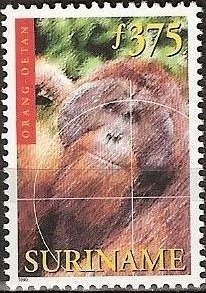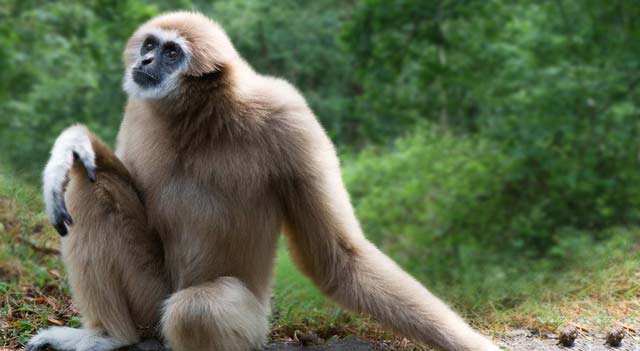Stamp: Bornean Orangutan (Pongo pygmaeus) (Suriname 1999)
Bornean Orangutan (Pongo pygmaeus) (Suriname 1999)
30 June (Suriname ) within release Animals goes into circulation Stamp Bornean Orangutan (Pongo pygmaeus) face value 375 Surinamese guilder
| Stamp Bornean Orangutan (Pongo pygmaeus) in catalogues | |
|---|---|
| Michel: | Mi:SR 1696 |
Stamp is square format.
Also in the issue Animals:
- Stamp - African Elephant (Loxodonta africana) face value 450;
- Stamp - American Flamingo (Phoenicopterus ruber) face value 75;
- Stamp - Bornean Orangutan (Pongo pygmaeus) face value 375;
- Stamp - Blue Whale (Balaenoptera musculus) face value 500;
- Stamp - Dyeing Poison Frog (Dendrobates tinctorius) face value 850;
- Stamp - White Rhinoceros (Ceratotherium simum) face value 900;
- Stamp - Giant Panda (Ailuropoda melanoleuca) face value 1600;
- Stamp - Tiger (Panthera tigris) face value 7250;
Stamp Bornean Orangutan (Pongo pygmaeus) it reflects the thematic directions:
Animals are multicellular, eukaryotic organisms of the kingdom Animalia (also called Metazoa). All animals are motile, meaning they can move spontaneously and independently, at some point in their lives. Their body plan eventually becomes fixed as they develop, although some undergo a process of metamorphosis later on in their lives. All animals are heterotrophs: they must ingest other organisms or their products for sustenance.
Apes (collectively Hominoidea /hɒmɪˈnɔɪdi.ə/) are a clade of Old World simians native to sub-Saharan Africa and Southeast Asia (though they were more widespread in Africa, most of Asia, and Europe in prehistory), which together with its sister group Cercopithecidae form the catarrhine clade, cladistically making them monkeys. Apes do not have tails due to a mutation of the TBXT gene. In traditional and non-scientific use, the term ape can include tailless primates taxonomically considered Cercopithecidae (such as the Barbary ape and black ape), and is thus not equivalent to the scientific taxon Hominoidea. There are two extant branches of the superfamily Hominoidea: the gibbons, or lesser apes; and the hominids, or great apes.


